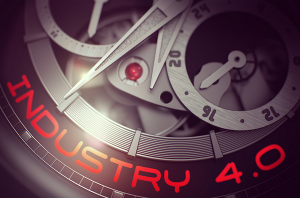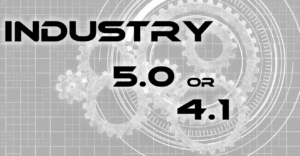Prior to the novel coronavirus outbreak, many pundits believed we were in the midst of a fourth industrial revolution. Analysts from the Boston Consulting Group (BCG) explain the first three revolutions were driven by steam, electricity, and automation. They write, “Industrial production was transformed by steam power in the nineteenth century, electricity in the early twentieth century, and automation in the 1970s.”[1] The fourth revolution, they insist, is being driven by data. The BCG analysts explain, “Today, another workforce transformation is on the horizon as manufacturing experiences a fourth wave of technological advancement: the rise of new digital industrial technologies that are collectively known as Industry 4.0.” Jamie Hinton (@jamiehinton), founder and CEO of Razor, agrees industrial transformation is being driven by data; however, he doesn’t think the transformation is revolutionary. He explains, “What’s happening today isn’t industry 4.0 — it’s an evolution of the digital revolution that started in the 1950s.”[2] He’s not alone in his thinking. Elhay Farkash (@ElhayfLightapp), CEO of Lightapp, agrees Industry 4.0 is more evolutionary than revolutionary. He also believes Industry 4.0 is currently more hype than reality. He writes, “The term provides marketers a framework to reposition some technologies that are getting a bit long in the tooth, while the real transformation has yet to happen.”[3]
Will the pandemic accelerate Industry 4.O?
Sudip Mazumder (@sumazu2009), Head of Digital, E&C Digital Head & General Manager at Larsen & Toubro Group, believes the novel coronavirus outbreak will not only accelerate Industry 4.0 but leapfrog many manufacturers into Industry 4.X. He explains, “One common thing that showed up as overwhelmingly important, is human health. All developments can be considered, all frameworks may be conceptualized, all economic activities may be carried out centering around the human being and human health. … Given the understanding of importance of the human health needs and at the same time economic needs to open up Industry to produce, supply and consume goods from the same factory, the time has come to think of human beings, their health, connected environments with machines and [humans] simultaneously as a part of connected operations which can possibly be referred as Industry 4.X or I4.X. Post COVID-19, I4.X will be more relevant than 4.0 as the concept takes care of holistic needs of human beings who are running the operations.”[4] In other words, Mazumder believes too much Industry 4.0 focus has been on technology and not enough attention has been given to the people who will make it work.
Mazumder may be correct; however, other analysts believe Industry 4.0 will be accelerated in an effort to eliminate humans from manufacturing processes because machines don’t get sick. Jennifer Smith (@jensmithWSJ) reports, “Decisions are taking place across scores of loading docks, warehouses and logistics management offices as companies of all sizes take a new look at technology that can help them adapt their operations to a changing business landscape under coronavirus restrictions. Supply-chain upheaval from the pandemic is presenting the tech world with a sudden and unexpected proving ground for automation, digital platforms and other tools that had been low on the priority lists for companies’ logistics operations. From delivery software to mobile robots that help workers fulfill e-commerce orders, those offerings are drawing attention in industries where thin margins have often left companies clinging to older, highly manual operations.”[5]
Connectivity is the essential trait of Industry 4.0
Mazumder observes Industry 4.0 is based on multiple principles, such as:
- Connectivity. According to Mazumder, there must be “connectivity between and amongst devices, sensors, gateways via [the Internet of Things (IoT)].”
- Improved Decision-making. Mazumder believes Industry 4.0 involves a “centralized view of operations yet decentralized decision-making by the way of making information available to the right people at the right time.”
- Integrated data. Mazumder insists there must be “transparency of information to the appropriate set of people and for the system as whole for any kind of eventuality or decision-making.”
- Advanced analytics. According to Mazumder, you can’t discuss Industry 4.0 without talking about data and its analysis. He explains manufacturers need to be “analytics driven [in order to understand the] ‘why’ and ‘how’ along with [the] ‘what’ and ‘when’.”
Peter Fretty (@pfretty) agrees with Mazumder that connectivity is the sine qua non of Industry 4.0. He writes, “Connectivity is a key component to building the factory of the future. Having the right standards in place provides consistency. … As manufacturers continue to morph operations into factories of the future, there is a growing demand for more harmonized systems that account for devices at the edge.”[6] As Farkash noted above, some technologies are getting long in the tooth and that can create standardization challenges. Fretty explains, “Most factory floors today leverage a mishmash of connectivity options. When combined with the growing array of applications dependent on stable wireless connections, it is easy to see how coexistence between the various interfaces that may exist in a factory could be an issue.” Without standardization, Industry 4.0 will remain aspirational.
Concluding thoughts
Daniel Laboe, a strategist at Zacks, notes, “The 4th industrial revolution is just commencing, and technological advances are already accelerating past most people’s understanding. This is only the beginning. Once the development of AI hits a critical stage, information and technology will proliferate incomprehensively. … 5G technology is the catalyst driving this latest revolution. 5G is much more than simply the next evolution of smartphones. Because of the blinding speed, expansive bandwidth and reliability of 5G, we will finally be able to experience the full capabilities of the Internet of Things, artificial intelligence and more. And just like each of the previous industrial evolutions, we’ll begin seeing the creation of new technologies that were previously unimaginable. “[7] Mazumder believes companies should be looking beyond just connecting machines via the IoT; he believes companies need to connect people with machines as they transform to Industry 4.0. He explains, “It has almost become mandatory to have the people in the workplace connected … within the same ‘connected’ machines environment.” The pandemic will undoubtedly motivate companies to consider how they employ both machines and people. They may well find a balance that accelerates how Industry 4.0 succeeds in the years ahead.
Footnotes
[1] Markus Lorenz, Michael Rüßmann, Rainer Strack, Knud Lasse Lueth, and Moritz Bolle, “Man and Machine in Industry 4.0,” bcg.perspectives, 28 September 2015.
[2] Jamie Hinton, “Is Industry 4.0 Just A Hype?” Manufacturing & Logistics IT, 14 March 2020.
[3] Elhay Farkash, “Industry 4.0: Don’t Believe the Hype, Yet,” IndustryWeek, 1 November 2019.
[4] Sudip Mazumder, “Leapfrogging into Industry 4.x: A post Covid 19 perspective,” Express Computer, 3 June 2020.
[5] Jennifer Smith, “Coronavirus Upheaval Triggers Corporate Search for Supply-Chain Technology,” The Wall Street Journal, 29 April 2020.
[6] Peter Fretty, “Standards Enabling Factory of the Future,” IndustryWeek, 13 May 2020.
[7] Daniel Laboe, “The 4th Revolution: Two-and-a-Half Centuries of Innovation,” Nasdaq, 25 March 2020.





